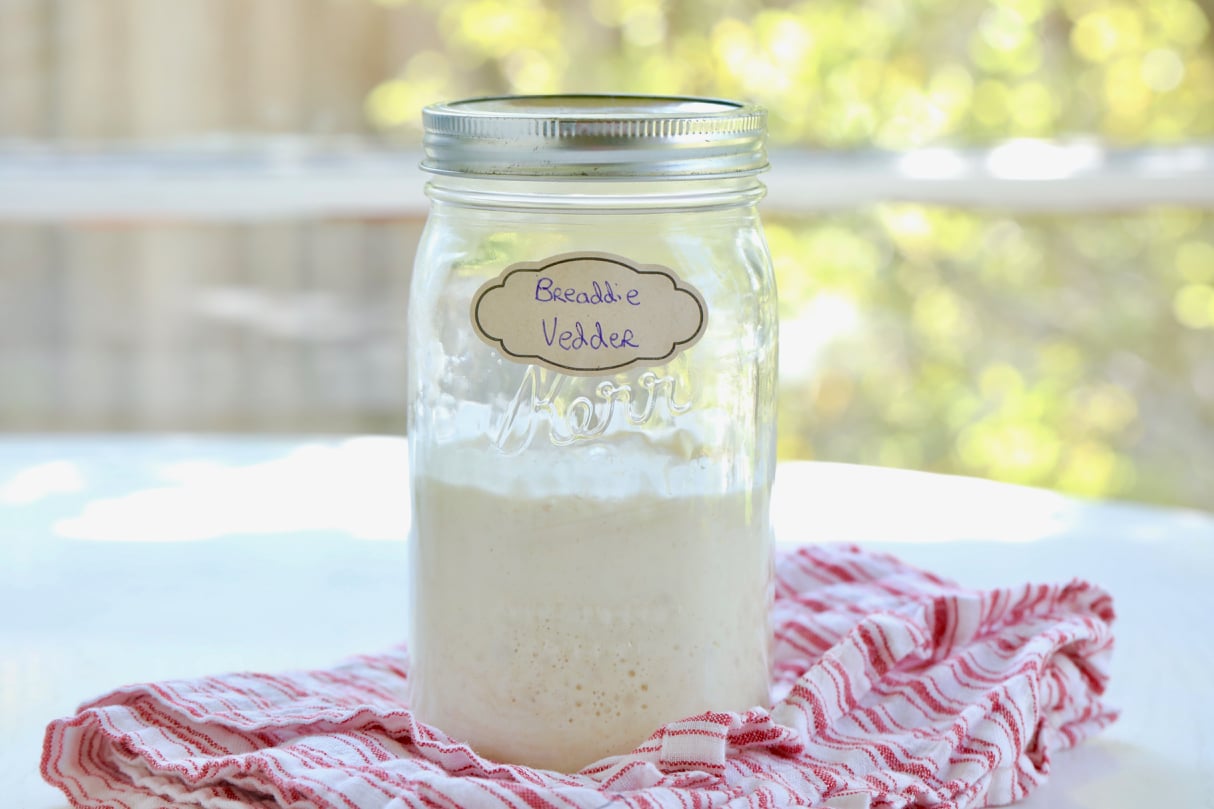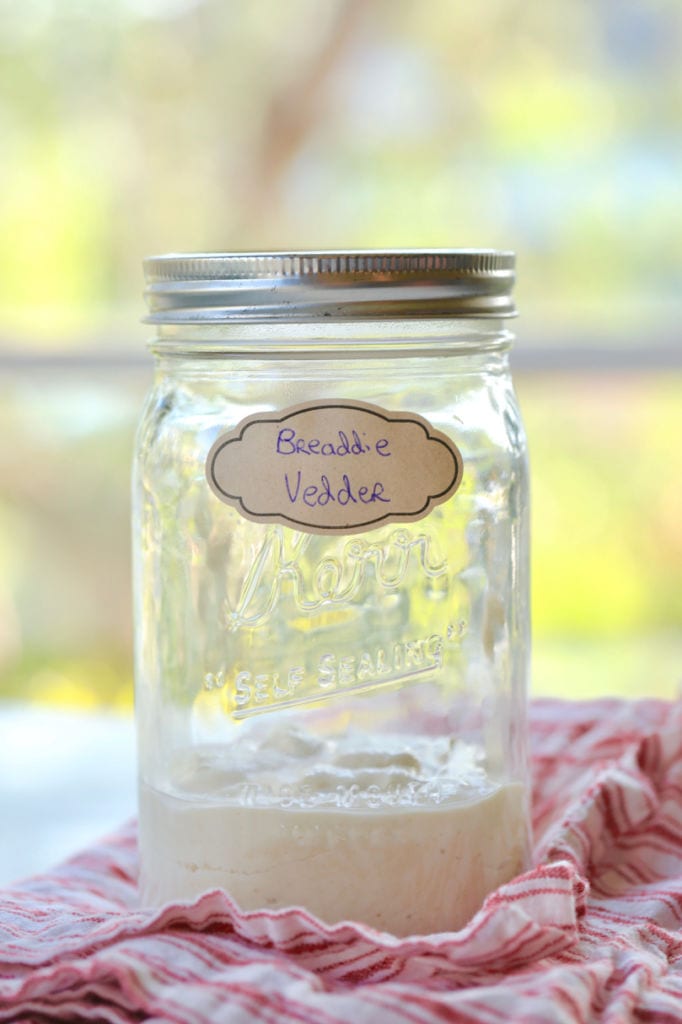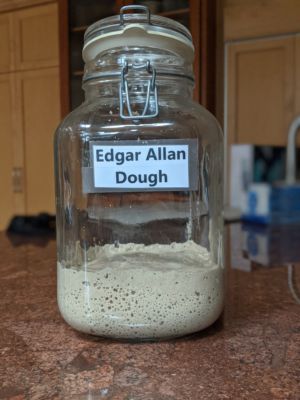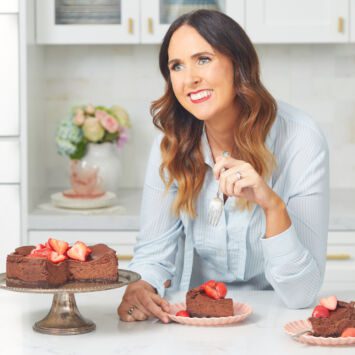
This post may contain affiliate links. Please see my full disclosure for details.
Hi Bold Bakers!
I know I’m not alone here when I say I have tried and failed before with complicated sourdough starter recipes — but this time it’s different! I was determined to keep my sourdough starter alive AND to be able to successfully bake with it. And you know what? I’ve been successful, so that means you can be, too.
Let me tell you a little something about me and how I consume information: It HAS to be straight forward, to the point, and explained well with no unnecessary step for the sake of it! I need just the facts and that’s it! Otherwise, I am absolutely lost and can’t make sense of the recipe.
[ Already have your starter up and running? Make my Sourdough Bread Recipe for Beginners! ]
I searched the internet for a straight forward, no unnecessary fluffy-stuff method on creating a sourdough starter and I came across Emilie from The Clever Carrot. She knows a thing or two about sourdough specifically as she is the author of Artisan Sourdough made Simple. I followed her easy steps and it resulted in a foolproof, perfect sourdough starter.
Following extensive practice, myself and my team of sourdough experts created a comprehensive sourdough guide with hundreds of your questions and answers that we have received, and created the internet’s MOST detailed and thorough Sourdough Q&A. Don’t forget to check it out!

What Is A Sourdough Starter?
It’s the beginning of artisanal, bakery-style, homemade sourdough bread. At it’s most basic, it’s flour and water that’s been mixed together and left to sit, activating wild yeast already in the flour you’re using to create the rise and gas needed for that perfect loaf of homemade bread you’ve always dreamed of. That’s right: when you use the starter to make bread, you don’t need to add any instant or active dry yeast, because the natural yeast is already there and active.
What Do I Need To Make A Sourdough Starter?
You only need two ingredients and a vessel that can handle all the chemistry going on during the process — so I just recommend you stick to glass. It’s also very helpful if you have a way to weigh your bottle, ingredients, and starter.
- Whole Wheat Flour (You can also use Rye or a combination of the two)
- Water (around 80°)
- Digital Scale (not required, but VERY useful)
- Glass Jar, Mason Jar, or Bottle, I suggest something that’s 32 oz for room and for growth/doubling after feeding

What Do I Feed It?
Sourdough starter should be regularly fed with equal parts flour (unbleached) and water. You could use any combination of grain-based flours to feed your sourdough starter.
How To Make Your Sourdough Starter
- If you’re using a digital scale (which I recommend you do, but it’s not required), the first thing you should do is weigh your jar and write it down — in fact, it’s helpful to keep a small journal of notes in the beginning, but not necessary. This way you’ll always know the weight of your starter even if it never leaves its home! Of course, this is most helpful when you’re weighing everything in the process, but you can use other methods of measuring if a scale for weight isn’t available.
- Measure out your flour and measure out your water — making sure the water is warm enough. Using tap water is fine if it doesn’t have too much chlorine.
- Combine the two in your jar, making sure there’s no dry flour left and you’ve worked most the lumps out, mixing it into a paste-like consistency.
- Cover loosely to allow for expansion and the escape of some gases.
- Let it sit for 24 hours away from too much light in a warm and cozy spot.
- After 24 hours, begin your feeding regimen according to the detailed recipe down at the bottom of this page!
Seriously, that’s it. Two ingredients and time. If you have 5 minutes to stretch in the morning, you have 5 minutes to tend to your starter while it grows. Simple.
TROUBLESHOOTING
Why Doesn’t My Sourdough Starter Have Bubbles?
A happy sourdough starter should be active and bubbly. The live yeast and bacteria in the starter feeds off the sugars in the flour and expels CO2 and these ‘bubbles’ form. Generally, after each feeding, bubbles start to form in 4 to 12 hours.
If there aren’t any bubbles left, it is most likely because your starter ran out of food (flour) and it should be fed more frequently. Should your feeding schedule be every 12 hours, perhaps an increase in feeding will help revive your starter so feed every 8-12 hours until normal activity resumes.
If Your Sourdough Starter Isn’t Rising
It takes some time for a good sourdough starter to rise and fall predictably. There are a few factors that will ensure this:
- Use water with no chlorine/chloramine. Such chemicals will disrupt fermentation or even kill the yeast.
- The temperature of the water for feeding and the environment also plays a big factor — yeast favors warmer conditions.
- However, too hot temperature could kill the yeast. A moderate 80°F (26°C) is optimal, or room temperature if that’s all you have access to.
- Consider sticking your starter in the oven with the light on — an oven bulb will emit a delicate heat that can help the process along if needed.
- Regular feedings of flour and water will keep the yeast happy and healthy
How Much Sourdough Starter Do I Throw Out?
Generally, you throw away at least half of your starter every feeding. The reason for this being is that every time you feed your starter, it requires so much flour that it would become too much to handle if some starter weren’t initially discarded.
When Does A Sourdough Starter Go Bad?
A starter should generally smell sweet and slightly sour, it should look light in color as well. If the starter begins to create spots of pink, green, or dark brown that go beyond the surface of the starter then that’s a sign of bad bacteria growth so the starter should be discarded.
When Is It Ready To Bake With?
It is best to use the starter when it is at its peak height (look for when it’s doubled in size, which takes roughly 3-5 hours) during the rising and falling stages of growth. To test whether it’s ready to use: mix your starter to distribute bubbles evenly then drop a spoonful of starter into a bowl of water. If it floats, it’s ready to go. But if it drops to the bottom, allow it to rest for a few hours longer.

What Should It Smell Like?
A good starter should smell sweet, but slightly sour/boozy due to the fermentation. It should not smell bad however like socks or garbage.
What do I do if Dark Liquid Appears on my Sourdough Starter?
During the creation process, and even after your starter has been established, a dark liquid might appear on the surface and throughout the culture. It has a very stinky smell, similar to rubbing alcohol or gym socks. This liquid is called “hooch” and is an indication that your starter needs to be fed. Any time you see this liquid, it’s best to remove it along with any discolored starter present.
Below is a picture of my sourdough starter after I didn’t feed it for 6 weeks! I know I know, but in my defense I had a baby and kind of forgot about it in the fridge. Following the above instructions it just took me just 24 hours to bring it back to a happy and healthy starter ready to be used.

Tips and Tricks To Making A Sourdough Starter
- Consistent feedings of the starter at the same time every day will ensure proper starter growth.
- Temperature control the environment and the water for feeding. A moderate 80°F (26°C) is optimal.
- Be persistent! It takes time to get a strong starter fit for baking bread.
- A good starter should smell sweet with a slightly sour/yeasty scent.
- When you’re about to make bread, use the starter when it’s physically reached its peak level of rising with lots of bubbles at its surface. Use the water float test to be sure it’s ready.
- Place a rubber band or piece of masking tape around the jar to measure the starter’s growth as it rises.
Try These Other Bread Recipes!
- Perfectly Crusty Sourdough Bread for Beginners
- Sourdough Pizza Crust
- Whole Wheat Sourdough Bread
- No-Knead Artisanal Whole Wheat Bread
- No-Knead Cinnamon Raisin Bread
- Best-Ever Irish Soda Bread
And don’t forget to buy my Bigger Bolder Baking cookbook!
Watch The Recipe Video!
How to Make A Sourdough Starter Guide & Recipe
Ingredients
- 1/2 cup (2oz/60g) whole wheat flour* (see Recipe Notes for GLUTEN FREE options)
- 1/4 cup +2 tablespoons (3oz/86g) water (I used tap)
To Feed Your Starter You Need:
- 1/2 cup (2oz/60g) unbleached all-purpose flour
- 1/4 cup +1 tablespoon (2oz/60g) water
Instructions
Day 1: Making your Sourdough Starter
- Combine 1/2 cup (2oz/60g) of whole wheat flour and 1/4 cup +2 tablespoons (3oz/86g) of water in a large sealable glass jar. Mix with a fork until smooth; the consistency will be thick and pasty. Cover loosely with plastic wrap or small cloth, and let it rest in a warm spot, for 24 hours.*Tip: I recommend using an electric scale when making and working with sourdough as precision is important.
Day 2: Look for Bubbles
- Check to see if any bubbles have appeared on the surface. If you don’t see anything, it’s okay. The bubbles might have appeared and dissolved overnight while you were sleeping. You don’t have to do anything else now. Rest the starter in your warm spot for another 24 hours.
Day 3: Feed Your Starter
- Remove and discard approximately half of your starter from the jar. I did this by eyeballing it each time and it worked just fine. The texture will be stretchy and bubbly.
- Feed it with a 1/2 cup (2oz/60g) of all-purpose flour and 1/4 cup +1 tablespoon (2oz/60g) of water in the jar. Mix with a fork until smooth. The texture should resemble thick-ish batter or yogurt at this point, so add more water if needed. Cover loosely, and let rest in your warm spot for another 24 hours.
Days 4, 5 & 6: Keep on Feeding!
- Repeat the feeding process outlined on Day 3 (remove and discard half of the starter, and feed it with 1/2 cup (2oz/60g) of all-purpose flour and 1/4 cup +1 tablespoon (2oz/60g) of water. As the yeast begins to develop, your starter will rise, and bubbles will form on the surface and throughout the culture. When the starter falls, it’s time to feed it again.*Tip: Place a rubber band or piece of masking tape around the jar to measure the starter’s growth as it rises.
Day 7: A Sourdough Starter is Born!
- By now, your starter should have doubled in size. You should see plenty of bubbles, both large and small. The texture will be spongy and fluffy. It should smell boozy, but not like stinky like gym socks. Your starter is now active and ready to use!
Is Your Starter Ready to Use?
- Do the float test: Drop a teaspoon of bubbly starter in a jar of water; if it floats to the top you can use it.Please keep in mind, if your starter is not ready at this point which is quite common due to temperature issues, timing, and other factors, it is totally fine to continue the feeding process for 1-2 weeks or more. The flavor and texture will just get better with time.
I’m not ready to use my starter yet, what do I do?
- If you are not ready to use your starter that is no problem at all. Simply transfer it to a clean sealable jar and keep it in the fridge to use later. Once in the fridge, you only need to feed your starter once every 7 days. See ‘Storage Options’ below.
Starter Storage Options
- If you bake often, store your starter at room temperature (ideally between 78°F/25°C and 82°F/26°C) feeding it once a day to keep it active. If you plan to bake only once in a while, store it in the fridge to preserve its strength and feed it once a week. When ready to bake, store it at room temperature and feed it once/twice a day for 1-3 days or until it can predictably and reliably reach its peak.
How to Feed Your Sourdough Starter for Ongoing Care
- Begin by removing and discarding about half of your starter.
- Replenish what’s left in the jar with fresh flour (use all unbleached purpose flour) and water.
- Cover loosely, and let it rise at room temperature until bubbly and double in size. Once it falls, the bubbles will become frothy and eventually disappear. Then you’ll know it’s time to feed your starter again.
- Feed your starter everyday if it’s stored at room temperature. Feed it 1x a week if you keep it in the fridge.
What happens if I miss a feeding?
- If you miss a feeding, don’t worry — your starter is not going to die. It might look ugly (and smell horrendous) but it usually just needs a few feedings to perk back up. If you haven't fed in some time you might see a dark liquid might appear on the surface and throughout the culture. It has a very stinky smell, similar to rubbing alcohol or gym socks. This liquid is called “hooch” and is an indication that your starter needs to be fed. Any time you see this liquid, it’s best to remove it along with any discolored starter present.













Hi Gemma,
When we are feeding the refrigerated starter every week, are we to leave it at room temperature for 12hours or shall we feed it and rest it immediately into refrigerator?
Hi everyone,
My mother gave an idea. The discard starters from day 3- day 6 can be collected in one jar and be refrigerated. The collected discard starter can be used as a wet ingredient in making flatbread like chapati. Make the dough, rest it at room temperature for 30 min to an hour and make flatbread.
There is no difference in taste.
Thanks,
Shruthi.
I’ve named my DoughVid-19 in light of the pandemic. Can’t wait to use it.
Hi Gemma!
I was wondering if you could do a mug & spork giveaway. Please reply to my comment ; I would like to know. Also please stop deleting my comment. This comment has been deleted twice already.
Hi Gemma greetings,
So I was looking at flour online when I chanced upon King Arthur’s page on what all treats could be made using discard sourdough starter.
Here is the link:
https://www.kingarthurflour.com/recipes/collections/sourdough-discard-recipes
You could try out these if you want to…
Thanks,
Shruthi Achut
I made this starter and it was good!
Thank you!
Amazingly simple and fun to do I have been feeding my “breadzilla” the last 6 days and can’t wait to use it to turn into a sourdough loaf tomorrow. My husband is part Czech and has roots in Germany too so when I said I was starting a sourdough starter to make him a loaf he fell in love with me just that little bit more and had very happy nan memories come back when he gave it a good sniff. Thank you for making it so easy I have been trying to find a recipe that didn’t scare me… Read more »
Hey Gemma!
I started mine with all purpose flour because I can’t find anything else at the moment. Anyway, it’s day 3 now and I just did my first feeding, but I noticed that my starter has a strong cheese smell. It definitely has a strong sour smell but no sweet smell. I don’t know if it qualifies as smelling bad like feet. I don’t know if it means I’m actually growing bad bacteria. Should I throw it out?
So, after you keep it in the fridge and only feed it once a week, how do you know when you can use it? And do you take out half? Thanks!
Hi Gemma!
I was wondering if you could do a mug & spork giveaway. Please reply to my comment;I would like to know.
Thanks, Clarissa
I’ve been using active dry yeast for all my breads, but I’ve run out of dry yeast. I’ll give this recipe a try for sure!